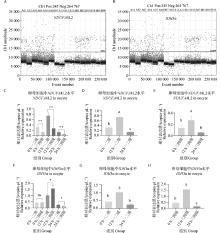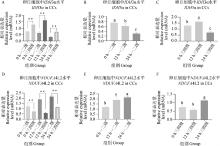





畜牧兽医学报 ›› 2025, Vol. 56 ›› Issue (9): 4432-4451.doi: 10.11843/j.issn.0366-6964.2025.09.025
王蕊( ), 衡诺, 胡樱凡, 王欢, 朱妮, 何维, 轩秀丽, 胡智辉, 熊铿, 巩建飞, 郝海生, 朱化彬, 赵善江*(
), 衡诺, 胡樱凡, 王欢, 朱妮, 何维, 轩秀丽, 胡智辉, 熊铿, 巩建飞, 郝海生, 朱化彬, 赵善江*( )
)
收稿日期:2025-03-11
出版日期:2025-09-23
发布日期:2025-09-30
通讯作者:
赵善江
E-mail:ruiwang202010@163.com;zhaoshanjiang@caas.cn
作者简介:王蕊(1999-),女,安徽马鞍山人,硕士,主要从事动物遗传育种与繁殖研究,E-mail: ruiwang202010@163.com
基金资助:
WANG Rui( ), HENG Nuo, HU Yingfan, WANG Huan, ZHU Ni, HE Wei, XUAN Xiuli, HU Zhihui, XIONG Keng, GONG Jianfei, HAO Haisheng, ZHU Huabin, ZHAO Shanjiang*(
), HENG Nuo, HU Yingfan, WANG Huan, ZHU Ni, HE Wei, XUAN Xiuli, HU Zhihui, XIONG Keng, GONG Jianfei, HAO Haisheng, ZHU Huabin, ZHAO Shanjiang*( )
)
Received:2025-03-11
Online:2025-09-23
Published:2025-09-30
Contact:
ZHAO Shanjiang
E-mail:ruiwang202010@163.com;zhaoshanjiang@caas.cn
摘要:
旨在探究不同等级牛卵丘-卵母细胞复合体(cumulus-oocyte complexes, COCs)体外成熟后卵母细胞发育能力差异的分子机制。本试验以屠宰场卵巢来源的牛COCs为研究对象,参照国际胚胎技术学会手册根据卵丘细胞层数、卵丘细胞紧密程度和卵母细胞细胞质外观将牛COCs分为一二级(较好)和三四级(较差)两组,每组3次重复,每个重复组含100枚以上COCs,进行体外成熟培养。本研究通过Smart-seq2技术对成熟前后的一二级和三四级COCs的卵母细胞进行了转录组测序并对差异基因进行了分析验证,利用非靶向代谢组学技术对不同级别COCs的培养液进行了差异代谢物分析。结果显示:1)三四级COCs的卵母细胞体外成熟、受精后的卵裂率和囊胚率(60.59%±6.54%,22.11%±2.79%)显著低于一二级(78.09%±3.01%,32.56%± 4.33%,P<0.05);2)Smart-seq测序结果显示,体外成熟前一二级和三四级COCs的卵母细胞中共筛选出541个显著差异表达基因(DEGs),体外成熟22~24 h(体外成熟后)一二级和三四级卵母细胞中共筛选出860个显著DEGs,GO和KEGG富集分析结果显示,这些DEGs主要与糖代谢、氧化磷酸化信号通路相关;3)数字PCR结果显示,体外成熟前后三四级COCs的卵母细胞中糖酵解相关基因PKM和电子传递链复合物I相关抑制基因NDUFA4L2的拷贝数水平均显著低于一二级(P<0.01),体外成熟后三四级卵母细胞中电子供体生成相关基因IDH3α的拷贝数水平显著低于一二级(P<0.05);同样体外成熟前后三四级COCs的卵丘细胞中NDUFA4L2 mRNA表达水平显著低于一二级(P<0.05),但是PKM和IDH3α mRNA表达水平却显著高于一二级(P<0.05,P<0.01);4)代谢物分析结果显示,不同级别COCs的培养液中共鉴定出69种显著上调差异代谢物,71种显著下调差异代谢物,功能富集分析发现差异代谢物主要富集在三羧酸循环(TCA)、糖酵解/糖异生等代谢通路上,进一步对差异代谢物(α-D-葡萄糖、丙酮酸、乳酸)进行相对丰度分析发现三四级COCs成熟液中α-D-葡萄糖含量显著高于一二级(P<0.01)。5)在三四级COCs体外成熟液中添加糖酵解产物丙酮酸钠能够显著提高三四级COCs体外成熟、受精后的卵裂率(72.54%±4.79% vs. 61.71%±4.75%)和囊胚率(30.63%±4.15% vs. 22.72%±2.39%,P<0.05)。综上,本研究表明三四级COCs的卵母细胞体外成熟后发育能力差可能是由于其本身糖酵解活性较弱,加之其外围卵丘细胞能量底物供给不足,导致卵母细胞成熟时能量不足,发育能力受限;通过添加丙酮酸钠能够明显改善三四级COCs的卵母细胞体外成熟后发育能力,研究结果为提高COCs利用率和胚胎生产效率提供了理论依据。
中图分类号:
王蕊, 衡诺, 胡樱凡, 王欢, 朱妮, 何维, 轩秀丽, 胡智辉, 熊铿, 巩建飞, 郝海生, 朱化彬, 赵善江. 不同等级牛卵丘-卵母细胞复合体体外成熟后卵母细胞发育能力差异的机制分析[J]. 畜牧兽医学报, 2025, 56(9): 4432-4451.
WANG Rui, HENG Nuo, HU Yingfan, WANG Huan, ZHU Ni, HE Wei, XUAN Xiuli, HU Zhihui, XIONG Keng, GONG Jianfei, HAO Haisheng, ZHU Huabin, ZHAO Shanjiang. Mechanisms of Developmental Competence Differences of Oocytes from Different Grades of Bovine Cumulus-Oocyte Complexes after in Vitro Maturation[J]. Acta Veterinaria et Zootechnica Sinica, 2025, 56(9): 4432-4451.
表 1
ddPCR、qRT-PCR引物"
| 引物名称 Primer name | 引物序列(5′→3′) Sequence | 产物长度/bp PCR size | 退火温度/℃ Annealing temperature |
| GAPDH-Forward | CACCCTCAAGATTGTCAGCA | 103 | 58 |
| GAPDH-Reverse | GGTCATAAGTCCCTCCACGA | ||
| PKM-Forward | CCCACAGTCGGGATAACCTTG | 127 | 58 |
| PKM-Reverse | TCCAGAGGAACTCCGACG | ||
| IDH3α-Forward | TGCAATCTTCGAGTCGGTTCA | 130 | 60 |
| IDH3α-Reverse | CTTCGCAGCGTGGTCAAAAA | ||
| β-actin-Forward | GCCCTGAGGCTCTCTTCCA | 101 | 60 |
| β-actin-Reverse | GCGGATGTCGACGTCACA | ||
| NDUFA4L2-Forward | CGATGATCGGCTTCATTGGC | 103 | 59 |
| NDUFA4L2-Reverse | GGGTTGTTCTTTCGGTCCCA |
表 3
Smart-seq数据质量分析"
| 样本 Sample | Raw reads数量 Raw reads number | Clean reads数量 Clean reads number | Effective reads比率/% Effective reads rate | Mapped reads比率/% Mapped reads rate | Q30值/% Q30 value |
| GV1-1 | 45 674 378 | 43 982 102 | 96.29 | 94.42 | 95.75 |
| GV1-2 | 51 129 184 | 49 398 606 | 96.62 | 94.28 | 95.90 |
| GV1-3 | 54 554 672 | 52 536 610 | 96.30 | 93.81 | 95.99 |
| GV3-1 | 67 726 306 | 65 549 142 | 96.79 | 94.24 | 95.85 |
| GV3-2 | 48 507 034 | 46 525 878 | 95.92 | 93.56 | 95.79 |
| GV3-3 | 46 170 534 | 44 167 230 | 95.66 | 93.49 | 95.50 |
| MII1-1 | 54 309 472 | 53 026 116 | 97.64 | 95.64 | 96.20 |
| MII1-2 | 52 572 712 | 50 965 326 | 96.94 | 94.99 | 95.96 |
| MII1-3 | 58 974 948 | 57 600 648 | 97.67 | 95.27 | 96.35 |
| MII3-1 | 61 658 056 | 59 849 842 | 97.07 | 95.19 | 96.09 |
| MII3-2 | 65 222 820 | 62 237 638 | 95.42 | 93.64 | 95.80 |
| MII3-3 | 69 933 254 | 67 284 420 | 96.21 | 93.76 | 95.96 |

图 6
NDUFA4L2和IDH3α基因数字PCR验证结果 A. 体外成熟0、12、22~24 h的一二级和三四级卵母细胞DNA溶液中NDUFA4L2基因拷贝数散点图;B. 体外成熟0、12、22~24 h的一二级和三四级卵母细胞DNA溶液中IDH3α基因拷贝数散点图;C.体外成熟0、12、22~24 h的一二级和三四级卵母细胞DNA溶液中NDUFA4L2基因拷贝数柱状图;D. 体外成熟0、12、22~24 h的一二级卵母细胞DNA溶液中NDUFA4L2基因拷贝数柱状图;E. 体外成熟0、12、22~24 h的三四级卵母细胞DNA溶液中NDUFA4L2基因拷贝数柱状图;F. 体外成熟0、12、22~24 h的一二级和三四级卵母细胞DNA溶液中IDH3α基因拷贝数柱状图;G. 体外成熟0、12、22~24 h的一二级卵母细胞DNA溶液中IDH3α基因拷贝数柱状图;H. 体外成熟0、12、22~24 h的三四级卵母细胞DNA溶液中IDH3α基因拷贝数柱状图"


图 8
IDH3α和NDUFA4L2 qRT-PCR验证结果 A. 体外成熟0、12、22~24 h的一二级和三四级卵丘细胞IDH3α qRT-PCR检测结果(n=3);B.体外成熟0、12、22~24 h的一二级卵丘细胞IDH3α qRT-PCR检测结果(n=3);C. 体外成熟0、12、22~24 h的三四级级卵丘细胞IDH3α qRT-PCR检测结果(n=3);D. 体外成熟0、12、22~24 h的一二级和三四级卵丘细胞NDUFA4L2 qRT-PCR检测结果(n=3);E. 体外成熟0、12、22~24 h的一二级卵丘细胞NDUFA4L2 qRT-PCR检测结果(n=3);F. 体外成熟0、12、22~24 h的三四级卵丘细胞NDUFA4L2 qRT-PCR检测结果(n=3)"

表 4
添加丙酮酸钠对三四级卵母细胞发育能力的影响"
| 组别 Group | 培养COCs总数/枚 Total number of COCs cultivated | 卵裂数/枚 ((mean±SEM)%) Cleavage number | 囊胚数/枚 ((mean±SEM)%) Number of blastocysts |
| 一二级COCs First- and second-grade COCs | 412 | 313 (75.15±4.46) | 105 (33.02±2.76) |
| 三四级COCs+丙酮酸钠 Third- and fourth-grade COCs +sodium pyruvate | 322 | 234 (72.54±4.79)a | 71 (30.63±4.15)a |
| 三四级COCs Third- and fourth-grade COCs | 311 | 192 (61.71±4.75)b | 44 (22.72±2.39)b |
| 1 | VIANA J H . 2023 Statistics of embryo production and transfer in domestic farm animals[J]. Embr Tech Newsl, 2024, 42 (4): 31- 46. |
| 2 | KRISHER R L . The effect of oocyte quality on development[J]. J Anim Sci, 2004, 82 (E-Suppl): E14- E23. |
| 3 |
HOMER H A . The role of oocyte quality in explaining "Unexplained" infertility[J]. Semin Reprod Med, 2020, 38 (1): 21- 28.
doi: 10.1055/s-0040-1721377 |
| 4 |
GALLO A , ESPOSITO M C , BONI R , et al. Oocyte quality assessment in marine invertebrates: a novel approach by fluorescence spectroscopy[J]. Biol Res, 2022, 55 (1): 34.
doi: 10.1186/s40659-022-00403-4 |
| 5 |
JEENA L M , KUMAR D , RAHANGDALE S , et al. Effect of cumulus cells of cumulus-oocyte complexes on in vitro maturation, embryonic developmental and expression pattern of apoptotic genes after in vitro fertilization in water buffalo (Bubalus bubalis)[J]. Anim Biotechnol, 2020, 31 (2): 135- 141.
doi: 10.1080/10495398.2018.1554580 |
| 6 |
DE LOOS F , VAN VLIET C , VAN MAURIK P , et al. Morphology of immature bovine oocytes[J]. Gamete Res, 1989, 24 (2): 197- 204.
doi: 10.1002/mrd.1120240207 |
| 7 | RODRIGUEZ-VARELA C , HERRAIZ S , LABARTA E . Mitochondrial enrichment in infertile patients: a review of different mitochondrial replacement therapies[J]. Ther Adv Reprod Health, 2021, 15, 1343248568. |
| 8 |
HAO X , ZHAO J , RODRIGUEZ-WALLBERG K A . Comprehensive atlas of mitochondrial distribution and dynamics during oocyte maturation in mouse models[J]. Biomark Res, 2024, 12 (1): 125.
doi: 10.1186/s40364-024-00672-z |
| 9 |
YUN Y , LEE S , SO C , et al. Oocyte development and quality in young and old mice following exposure to atrazine[J]. Environ Health Perspect, 2022, 130 (11): 117007.
doi: 10.1289/EHP11343 |
| 10 |
PETERS A E , FORD E A , ROMAN S D , et al. Impact of Bisphenol A and its alternatives on oocyte health: a scoping review[J]. Hum Reprod Update, 2024, 30 (6): 653- 691.
doi: 10.1093/humupd/dmae025 |
| 11 | 安卓, 谢聪聪, 赵明, 等. 线粒体对卵母细胞发育的影响[J]. 生殖医学杂志, 2021, 30 (11): 1533- 1537. |
| AN Z , XIE C C , ZHAO M , et al. Eeffects of mitochondria on oocyte development[J]. Journal Reproductive Medicine, 2021, 30 (11): 1533- 1537. | |
| 12 |
XIONG Y Y , ZHU H Y , SHI R J , et al. Regulation of glucose metabolism: Effects on oocyte, preimplantation embryo, assisted reproductive technology and embryonic stem cell[J]. Heliyon, 2024, 10 (19): e38551.
doi: 10.1016/j.heliyon.2024.e38551 |
| 13 |
KOBAYASHI H , YOSHIMOTO C , MATSUBARA S , et al. Altered energy metabolism, mitochondrial dysfunction, and redox imbalance influencing reproductive performance in granulosa cells and oocyte during aging[J]. Reprod Sci, 2024, 31 (4): 906- 916.
doi: 10.1007/s43032-023-01394-7 |
| 14 |
NAHAR A , BECKER J , PASQUARIELLO R , et al. FGF2, LIF, and IGF-1 supplementation improves mouse oocyte in vitro maturation via increased glucose metabolismdagger[J]. Biol Reprod, 2024, 110 (4): 672- 683.
doi: 10.1093/biolre/ioae014 |
| 15 |
ZHANG Q , REN J , WANG F , et al. Mitochondrial and glucose metabolic dysfunctions in granulosa cells induce impaired oocytes of polycystic ovary syndrome through Sirtuin 3[J]. Free Radic Biol Med, 2022, 187, 1- 16.
doi: 10.1016/j.freeradbiomed.2022.05.010 |
| 16 |
PICELLI S , FARIDANI O R , BJORKLUND A K , et al. Full-length RNA-seq from single cells using Smart-seq2[J]. Nat Protoc, 2014, 9 (1): 171- 181.
doi: 10.1038/nprot.2014.006 |
| 17 |
OU Z , DU J , LIU N , et al. The impact of low oocyte maturity ratio on blastocyst euploidy rate: a matched retrospective cohort study[J]. Contracept Reprod Med, 2024, 9 (1): 41.
doi: 10.1186/s40834-024-00303-w |
| 18 |
PARRELLA A , IRANI M , KEATING D , et al. High proportion of immature oocytes in a cohort reduces fertilization, embryo development, pregnancy and live birth rates following ICSI[J]. Reprod Biomed Online, 2019, 39 (4): 580- 587.
doi: 10.1016/j.rbmo.2019.06.005 |
| 19 |
XIE H L , WANG Y B , JIAO G Z , et al. Effects of glucose metabolism during in vitro maturation on cytoplasmic maturation of mouse oocytes[J]. Sci Rep, 2016, 6, 20764.
doi: 10.1038/srep20764 |
| 20 |
ALVAREZ G M , BARRIOS E M , ELIA E , et al. Effects of gonadotrophins and insulin on glucose uptake in the porcine cumulus-oocyte complex during ⅣM[J]. Reprod Fertil Dev, 2019, 31 (8): 1353- 1359.
doi: 10.1071/RD18321 |
| 21 |
ABDULHASAN M K , LI Q , DAI J , et al. CoQ10 increases mitochondrial mass and polarization, ATP and Oct4 potency levels, and bovine oocyte MII during ⅣM while decreasing AMPK activity and oocyte death[J]. J Assist Reprod Genet, 2017, 34 (12): 1595- 1607.
doi: 10.1007/s10815-017-1027-y |
| 22 |
ZHANG Y , JIANG X , SONG X , et al. Mendelian randomization and multi-omics approach analyses reveal impaired glucose metabolism and oxidative phosphorylation in visceral adipose tissue of women with polycystic ovary syndrome[J]. Hum Reprod, 2024, 39 (12): 2785- 2797.
doi: 10.1093/humrep/deae244 |
| 23 |
BOLAND N I , HUMPHERSON P G , LEESE H J , et al. The effect of glucose metabolism on murine follicle development and steroidogenesis in vitro[J]. Hum Reprod, 1994, 9 (4): 617- 623.
doi: 10.1093/oxfordjournals.humrep.a138559 |
| 24 |
PROCHOWNIK E V , WANG H . The metabolic fates of pyruvate in normal and neoplastic cells[J]. Cells, 2021, 10 (4): 762.
doi: 10.3390/cells10040762 |
| 25 | LI Y R , PENG R R , GAO W Y , et al. The ubiquitin ligase KBTBD8 regulates PKM1 levels via Erk1/2 and Aurora A to ensure oocyte quality[J]. Aging (Albany NY), 2019, 11 (4): 1110- 1128. |
| 26 | LIU Z , CHAILLOU T , SANTOS A E , et al. Mitochondrial NDUFA4L2 is a novel regulator of skeletal muscle mass and force[J]. FASEB J, 2021, 35 (12): e22010. |
| 27 |
CHEN Y C , LI J Y , LI C J , et al. Luteal phase ovarian stimulation versus follicular phase ovarian stimulation results in different human cumulus cell genes expression: A pilot study[J]. Int J Med Sci, 2021, 18 (7): 1600- 1608.
doi: 10.7150/ijms.55955 |
| 28 |
HOU J Y , WANG X L , CHANG H J , et al. PTBP1 crotonylation promotes colorectal cancer progression through alternative splicing-mediated upregulation of the PKM2 gene[J]. J Transl Med, 2024, 22 (1): 995.
doi: 10.1186/s12967-024-05793-5 |
| 29 |
WEN J , WANG G L , YUAN H J , et al. Effects of glucose metabolism pathways on nuclear and cytoplasmic maturation of pig oocytes[J]. Sci Rep, 2020, 10 (1): 2782.
doi: 10.1038/s41598-020-59709-6 |
| 30 |
SUTTON-MCDOWALL M L , GILCHRIST R B , THOMPSON J G . The pivotal role of glucose metabolism in determining oocyte developmental competence[J]. Reproduction, 2010, 139 (4): 685- 695.
doi: 10.1530/REP-09-0345 |
| 31 | 赵昍朋, 李宝山, 程东凯. 颗粒细胞糖脂代谢对卵母细胞发育影响的研究进展[J]. 妇儿健康导刊, 2024, 3 (15): 22- 26. |
| ZHAO X P , LI B S , CHENG D K . Research progress on the effects of granulosa cell glucose and lipid metabolism on oocyte development[J]. Fuer Jiankang Daokan, 2024, 3 (15): 22- 26. | |
| 32 |
DALTON C M , SZABADKAI G , CARROLL J . Measurement of ATP in single oocytes: impact of maturation and cumulus cells on levels and consumption[J]. J Cell Physiol, 2014, 229 (3): 353- 361.
doi: 10.1002/jcp.24457 |
| 33 | SHI L , WANG H , ZHU S , et al. Multi-omics reveal the metabolic changes in cumulus cells during aging[J]. Cell Prolif, 2025, e70014. |
| 34 |
ZHANG Q , HAO J X , LIU B W , et al. Supplementation of mitochondria from endometrial mesenchymal stem cells improves oocyte quality in aged mice[J]. Cell Prolif, 2023, 56 (3): e13372.
doi: 10.1111/cpr.13372 |
| 35 |
MEI N H , GUO S M , ZHOU Q , et al. H3K4 methylation promotes expression of mitochondrial dynamics regulators to ensure oocyte quality in mice[J]. Adv Sci (Weinh), 2023, 10 (12): e2204794.
doi: 10.1002/advs.202204794 |
| 36 |
ZHANG Y , LIU L , YIN T L , et al. Follicular metabolic changes and effects on oocyte quality in polycystic ovary syndrome patients[J]. Oncotarget, 2017, 8 (46): 80472- 80480.
doi: 10.18632/oncotarget.19058 |
| 37 |
MOORE S G , FAIR T , LONERGAN P , et al. Genetic merit for fertility traits in Holstein cows: Ⅳ. Transition period, uterine health, and resumption of cyclicity[J]. J Dairy Sci, 2014, 97 (5): 2740- 2752.
doi: 10.3168/jds.2013-7278 |
| 38 |
CAI X , NG C P , JONES O , et al. Lactate activates the mitochondrial electron transport chain independently of its metabolism[J]. Mol Cell, 2023, 83 (21): 3904- 3920.
doi: 10.1016/j.molcel.2023.09.034 |
| 39 |
LIU K , WEI H , NONG W , et al. Nampt/SIRT2/LDHA pathway-mediated lactate production regulates follicular dysplasia in polycystic ovary syndrome[J]. Free Radic Biol Med, 2024, 225, 776- 793.
doi: 10.1016/j.freeradbiomed.2024.10.312 |
| 40 |
MATSUMOTO Y , NAKASHIMA T , CHO O , et al. Pyruvate-triggered TCA cycle regulation in Staphylococcus aureus promotes tolerance to betamethasone valerate[J]. Biochem Biophys Res Commun, 2020, 528 (2): 318- 321.
doi: 10.1016/j.bbrc.2020.05.035 |
| 41 |
YIEW N , FINCK B N . The mitochondrial pyruvate carrier at the crossroads of intermediary metabolism[J]. Am J Physiol Endocrinol Metab, 2022, 323 (1): E33- E52.
doi: 10.1152/ajpendo.00074.2022 |
| 42 |
GONZALES-FIGUEROA H , GONZALES-MOLFINO H M . Maturation of pig oocytes in vitro in a medium with pyruvate[J]. Braz J Med Biol Res, 2005, 38 (6): 869- 872.
doi: 10.1590/S0100-879X2005000600008 |
| 43 |
JOHNSON M T , FREEMAN E A , GARDNER D K , et al. Oxidative metabolism of pyruvate is required for meiotic maturation of murine oocytes in vivo[J]. Biol Reprod, 2007, 77 (1): 2- 8.
doi: 10.1095/biolreprod.106.059899 |
| [1] | 张紫璇, 于雯靖, 王中华, 董旭晟, 侯秋玲. 奶牛乳腺发育评估技术及应用研究进展[J]. 畜牧兽医学报, 2025, 56(9): 4176-4190. |
| [2] | 曹晓瑶, 汪聪勇, 王亭, 熊兰玲, 于河洋, 王泽昭, 高会江, 李俊雅, 朱波. 华西牛群体生长发育性状遗传参数估计及其遗传进展[J]. 畜牧兽医学报, 2025, 56(9): 4355-4368. |
| [3] | 郑云畅, 侯睿霖, 梁晓贺, 杨利丹, 张银蛟, 霍浩楠, 陈玮娜, 张萃, 李世杰. 牛FOXP2基因的单等位基因表达和DNA甲基化状态分析[J]. 畜牧兽医学报, 2025, 56(9): 4369-4378. |
| [4] | 夏春秋, 苗舒, 李志青, 刘磊, 万发春, 沈维军. 缬氨酸通过AMPK/mTOR信号通路调控牛成肌细胞增殖[J]. 畜牧兽医学报, 2025, 56(9): 4491-4506. |
| [5] | 马思琪, 吕雯雯, 陈俊贞, 李建林, 刘昱成, 关团, 丁剑, 刘浩然, 叶鸿艳, 杨莉, 付强, 史慧君. 牛肠病毒VP1基因重组腺病毒的构建及其对小鼠的免疫原性评价[J]. 畜牧兽医学报, 2025, 56(9): 4615-4625. |
| [6] | 杨书博, 苑庆欣, 陈麒百, 王培, 高东阳, 李鹤, 宋军. 金黄色葡萄球菌噬菌体脂质体的制备及胞内抗菌活性[J]. 畜牧兽医学报, 2025, 56(9): 4638-4645. |
| [7] | 刘佳金, 温小庆, 罗春海, 贾红豆, 王薇, 李丹阳, 付世新. FoxO1对高NEFA诱导的奶牛子宫内膜上皮细胞凋亡因子表达的影响[J]. 畜牧兽医学报, 2025, 56(9): 4708-4717. |
| [8] | 杨文哲, 王锦浩, 赵子琛, 赵彤, 潘飞龙, 陈芳芳, 邵雯琪, 刘克祥, 赵树臣, 赵立佳. 姜黄素影响铁死亡途径缓解LPS诱导牛乳腺上皮细胞炎性反应的分析[J]. 畜牧兽医学报, 2025, 56(9): 4730-4740. |
| [9] | 万琼飞, 石闪闪, 郭若楠, 吕航, 胡德宝, 郭益文, 张林林, 丁向彬, 郭宏, 李新. 牛胚胎期肌肉发育关键lncRNA的筛选及功能分析[J]. 畜牧兽医学报, 2025, 56(8): 3802-3812. |
| [10] | 袁越, 周建旭, 罗晓林, 官久强, 安添午, 赵洪文, 柏琴, 任子利, 张翔飞, 赵彦玲. 过瘤胃脂肪对育肥牦牛生产性能、血清生化及屠宰性能的影响[J]. 畜牧兽医学报, 2025, 56(8): 3849-3860. |
| [11] | 包小平, 崔俊伟, 赵玉龙, 郭成, 陈明, 毕研亮. 产后不同挤奶时间对初乳品质及不同品质初乳对新生犊牛被动免疫转移的影响[J]. 畜牧兽医学报, 2025, 56(8): 3861-3871. |
| [12] | 王琳玮, 王靖, 韩赛波, 李涵川, 王盼盼, 郭刚, 蒋林树. 植物精油对哺乳期犊牛血清免疫及生化指标影响的Meta分析[J]. 畜牧兽医学报, 2025, 56(8): 3872-3892. |
| [13] | 时文健, 徐磊, 张泽, 杨蕊, 辛凌翔, 王楠, 陈祥, 鑫婷. 基于结核分枝杆菌牛变种C68001随机突变体库筛选和鉴定成膜相关基因[J]. 畜牧兽医学报, 2025, 56(8): 3992-4006. |
| [14] | 赵峂, 王亚慧, 吴天弋, 高晨, 高霄霄, 张路培, 高会江, 李俊雅. 过表达和干扰PRKD1基因对牛成骨细胞分化的影响[J]. 畜牧兽医学报, 2025, 56(7): 3188-3198. |
| [15] | 白媛媛, 蔡雯祎, 邢嘉仪, 姜雨婷, 麻志伟, 吉文汇, 兰道亮. 牦牛、犏牛和黄牛肺脏比较转录组图谱研究[J]. 畜牧兽医学报, 2025, 56(7): 3226-3243. |
| 阅读次数 | ||||||
|
全文 |
|
|||||
|
摘要 |
|
|||||
